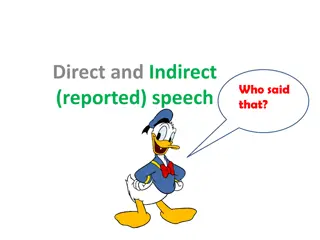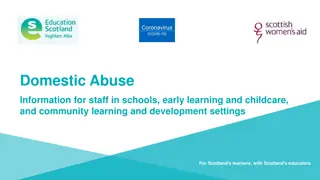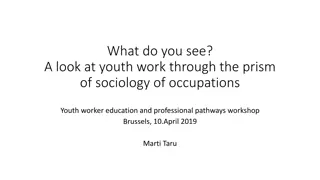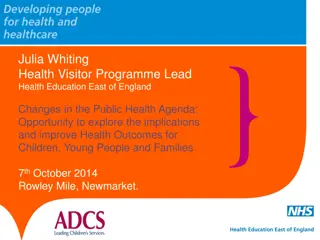Direct Work Strategies for Children and Young People: Newham Children Services Practitioners Workshop 2020
Explore the fundamentals of direct work with children and young people in the Newham Children Services Practitioners Workshop 2020. Discover the purpose, planning, and application of direct work, focusing on outcomes and challenges. Learn to apply a systemic and restorative approach, utilizing solution-focused techniques to support children in reaching their goals. Consider the impact of abuse and neglect on children and the importance of understanding social contexts in intervention strategies.
Download Presentation

Please find below an Image/Link to download the presentation.
The content on the website is provided AS IS for your information and personal use only. It may not be sold, licensed, or shared on other websites without obtaining consent from the author. Download presentation by click this link. If you encounter any issues during the download, it is possible that the publisher has removed the file from their server.
E N D
Presentation Transcript
NEWHAM CHILDREN SERVICES PRACTITIONERS WORKSHOPS 2020 Direct Work with children and young people
Workshop Overview 1. Welcome and Overview 2. Introduction to the fundamentals of Direct Work 3. Context and Planning Direct Work (7-15) 4. Direct work a practitioners experience 5. Experiment in direct work zoom workshops 6. What works, what is a challenge? 7. Round up, review and Feedback 2
Fundamentals of Direct Work Direct Work needs to link to the Organisational Purpose. To develop a coherent Restorative Culture and Systemic model of practice across Newham social care services. A model that both improves outcomes for children and enhances the confidence, commitment and retention of staff working alongside the community. 3
Fundamentals of Direct Work Purposeful.What is the purpose of the direct work you are doing, what outcome do you want to achieve, what strength/issue/risk/problem are you addressing. What needs to change so you know you have achieved your purpose? Planned.How will you ensure that you are clear about the purpose of the direct work, who needs to do what when and how will they do this. How will you get feedback to know if the plan has achieved its purpose? Focussed. What are you or the worker going to be doing in each direct work contact you/they have with the child or young person. How can you or the worker stay focussed on the plan in the face of the challenges that will be faced? How does supervision support the above? 4
Application of the Practice Model. Explore in supervision how you can apply your understanding of a systemic model with a restorative approach to your direct work. Understand your position and the part you play. Be reflexive. A systemic approach is a way of acting, thinking and viewing the world, which focuses on relationships and recognises that individuals are always embedded in their social context. Be creative and curious in exploring ways with a child/young person to understand their social context and networks. Try a genogram, a timeline or ecomap and reflect with the child/young person. 5
Simply solution focussed 6 The above is a direct work approach that uses a solution focussed approach to help a child or young person focus on exploring how to reach their goals.
What we need to consider when planning Direct Work. Context. The impact of abuse and neglect on children and young people Key points- Neglect is one of the most prevalent forms of maltreatment. It can be difficult to identify and to evidence whether the threshold for social work intervention or court action has been reached. Neglect also occurs in the context of other factors. Individual, community and societal factors interact in complex ways to increase or decrease the risk and impact of maltreatment. Protective factors make a difference. Earlier, effective support to care givers whilst keeping the child s welfare in mind can reduce the risk of harm. 1
Impact of abuse and neglect on the child and young person s development Neglect and abuse occur along spectrums of severity and the evidence suggests that the more chronic the experience the more marked the symptoms of trauma in childhood and adolescence. There is evidence that suggests neglect can be a particularly damaging form of maltreatment. There is evidence to suggest that for many children and young people neglect has significant implications for a range of developmental dimensions. Neglected infants and toddlers can show a dramatic decline in overall developmental scores between the ages of 9-24 months and a progressive decline in cognitive functioning in the pre-school years. In addition, neglected infants who display secure attachment behaviour may increasingly develop insecure or disorganised attachments as they grow older. The longer the experience of neglect the greater the harm. 8
Impact of abuse and neglect on the child and young person s development The longer-term impact in young people can manifest in increased vulnerability in adolescence compared to those who have been physically abused. Potentially increasing vulnerability to maltreatment, victimisation and sexual exploitation. Impact on physiological functioning. For some young people type and duration of neglect and abuse can impact significantly on their emotional and behavioural adaptions. The body s systemic response to stress. Acute stress can cause long term consequences-PTSD, increase the chronic development of diseases, cardiovascular, diabetes. 9
Impact of abuse and neglect on the child and young person s development The impact on abuse and neglect on mental health can lead to the following in childhood and adulthood- Depressive disorders Anxiety disorders Eating disorder Behavioural and conduct disorders Drug use Vulnerability to sexual exploitation 10
An analysis of serious case reviews in 2011 - 2014 Identified neglect featured prominently in the experience of adolescents at the centre of the reviews. The analysis identified that the impact of abuse and neglect on these young people was not acknowledged by some professional working with them. In some cases, the young person was wrongly seen as resilient because they were articulate and troublesome . The tendency for young people to be seen as streetwise, resilient and troublesome (rather than troubled) and for their behaviours to obscure their vulnerabilities and strengths can contribute to sometimes unhelpful approaches in assessing need and engagement through direct work by practitioners. 11
Confident Direct Work with Children and Young People What is direct work? Direct Work should always have a specific purpose and can be used in a number of situations - It can include Exploring children and young peoples memories of events Helping children and young people to process traumatic experiences. Helping children and young people move to a new family or placement Undertaking life story work Helping with social aspects of the child or young persons life. Helping with assessing the child or young persons wishes and feelings to inform planning. 12
Building a Trusting Relationship Its only through a relationship with the child or young person that a practitioner can develop insights into the internal world and wishes and feelings. How we begin our relationship matters. The greeting and courtesy you extend, your presence and what you offer as pleasurable activities goes a long way to settle even the most diffident child or one who is experiencing conflict about talking to you. Recognising the hard emotional work that a child will do in direct work sessions and taking steps to create a nurturing/comfortable environment. Food and drink can be important for a child or young person to relax and not be distracted by being hungry or thirsty. The key factor that makes a difference as fed back by children and young people is the quality of the practitioners capacity to listen actively,to them and to hear the things they are not saying. 13
Preparation for Direct Work Preparation Have a clear and purposeful plan to carry out direct work and life story work.; Consider the child or young persons developmental level and remember some children may operate at a level Be aware of cultural factors and research these e.g. race, religion, identity issues, different family and community norms; Check your records, and your knowledge of background information and gather material on important events, the child or young persons life, their family names, pets etc. Consult and share at all stages of the work with the child or young persons carer and the supervising social worker. Involvement is crucial. The work may be painful for the child, so prepare for this Recognise your own feelings about personal experiences of loss and separation, grief and rejection as these may be triggered for you in your work with the child Discuss the progress of your work in regular supervision with your line manager where appropriate advice and guidance should be given. 14
Do... Get to know the child/young person as well as Be clear with the foster carer/residential worker, that the focus of the visit is to undertake life story work Do the work in a safe, comfortable environment and work physically on the child s level (e.g. usually on the floor). Solve problems and make choices Being flexible with the agenda for the session and working at the child pace would be beneficial; Find out what the child/young person can do well or what she/he enjoys. Acknowledge the child s feelings and give feedback of observations to the child; Respect confidences and be aware of what disclosures may need to be passed on. Explain why to the child/young person Be alert to non-verbal responses, e.g. body language, talking in thirdparty , eye contact etc. Be prepared to go over things several times and in different ways, to convey the same message. Children/Young People don t always hear things first time, particularly if it is painful. 15
Experiment in Direct Work workshops. Enter into three virtual zoom workshops and explore and discuss different material and resources that you can apply and use in your direct work with children and young people exploring different contexts. 16
Things to think about Confidentiality when discussing cases. Assessment and Planning. Think about how direct work informs your assessment and planning. 17
Evaluation What was helpful? What would I like more of? What next? 18























